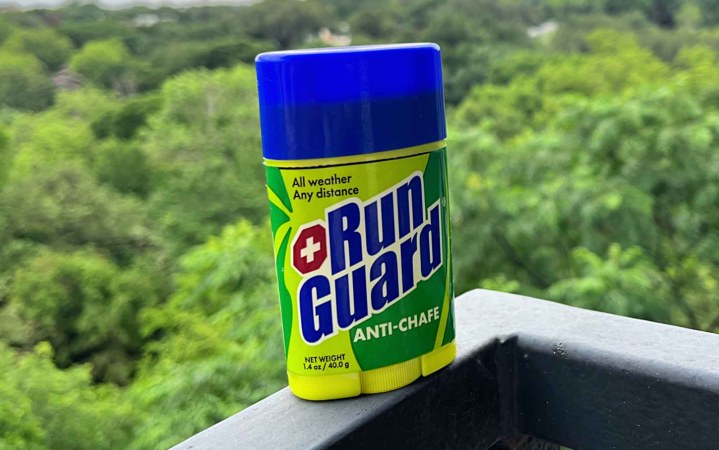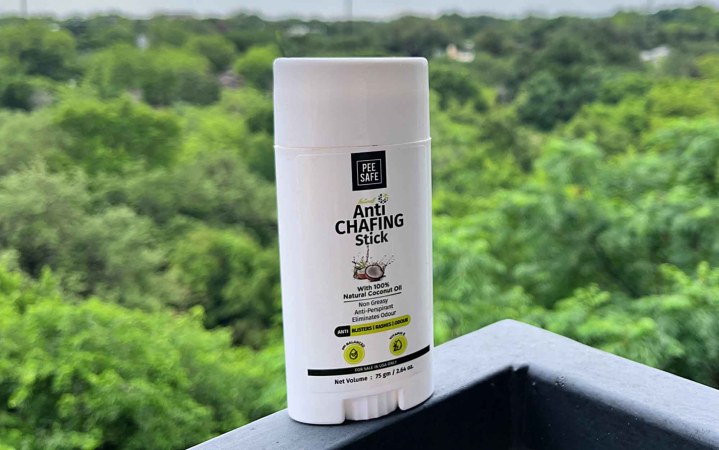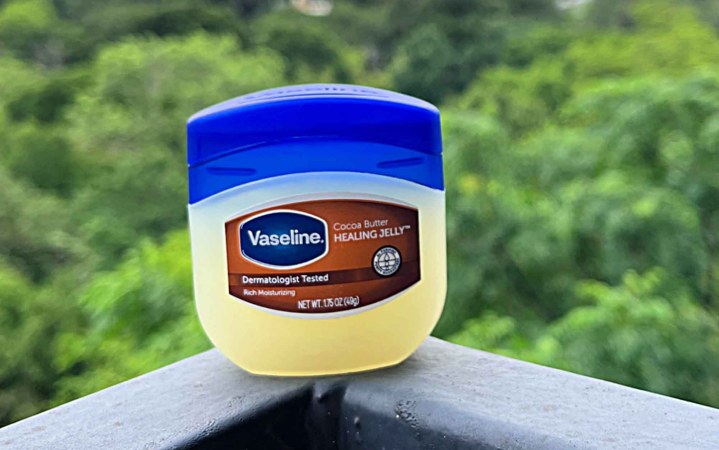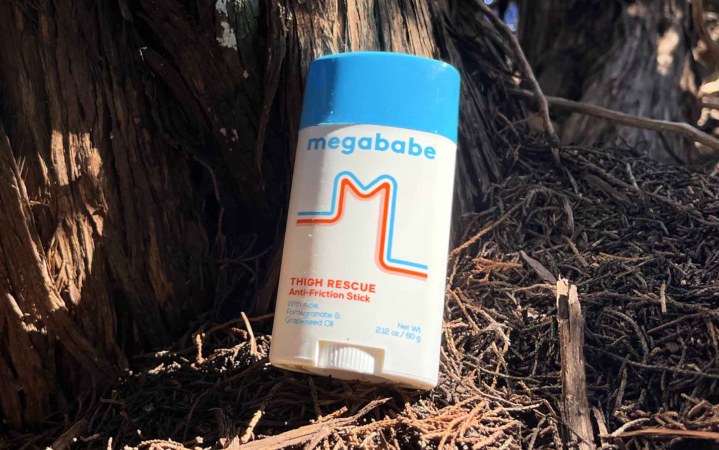We may earn revenue from the products available on this page and participate in affiliate programs. Learn More ›
Let’s get down to the sweaty truth about chafing. It can put a serious damper on hiking, running, biking, backpacking, or even just walking. Any sort of friction against the skin can cause it, whether that’s skin rubbing on skin, an ill-fitting waistband or bra strap, a heart rate monitor, or a heavy pack that’s been grinding your t-shirt into your collarbone for the last 7 miles. The results are pretty uniform. Red, painful rashes, bumps, blisters, and even bleeding and scarring are all possible outcomes. That’s why anti-chafing sticks and other products are so popular, although an ever-growing array of options might make it hard to pick the right one. Here are our top choices:
- Best Overall: Bodyglide Original Anti-Chafe Balm
- Best for Running: Run Guard
- Best for Feet: Squirrel’s Nut Butter
- Best Scented: PeeSafe Anti-Chafing Stick
- Best Already-in-Your-Cabinet: Vaseline Cocoa Butter
- Best Budget: Gold Bond Friction Defense
- Best All-Natural: Zone Naturals Chub Rub
- Best for the Frontcountry: Megababe Thigh Rescue Anti-Friction Stick
- Cleanest Application: KTHealth Chafe Safe Anti-Friction Balm
How I Tested the Best Anti-Chafing Sticks
Few activities cause worse chafing than good old-fashioned running, especially in shorts with loose fabric and warm, sticky weather. So I tested anti-chafing sticks in Austin, Texas, as temperatures started to climb and humidity increased, conditions that ensured the skin on my feet and thighs would start to rub. My runs varied from 4 to 9 miles and all of them were extremely sweaty. I wore the same pair of loose-fitting Athleta running shorts every time for the sake of consistency. Yes, I washed them between runs, and I’m pleased to announce that not a single one of the products in the lineup left any stains behind on the technical, celery-colored fabric.
Best Anti-Chafing Sticks: Reviews & Recommendations
Best Overall: Bodyglide Original Anti-Chafe Balm
Key Ingredients
- Caprylic/capric triglyceride
- Ozokerite wax
- Allantoin
Pros
- Very clean application, not crumbly or oily
- Truly unscented
- Long-lasting
- Water-resistant
Cons
- Difficult to build up a thick layer on the skin
If you’re looking for the most no-bullshit, unscented, swipe-and-go option that will protect you over long distances, Bodyglide has your back. The Original Anti-Chafe balm comes in four different sizes, so you can tuck a tiny one in your running vest or bino harness and keep the large stick back at camp or in your medicine cabinet. This product also has zero smell and a consistency that’s more balmy than oily. It has amassed a serious following in the wetsuit sports community, since its founder invented it to avoid belly rash without the wetsuit degradation that petroleum jelly causes. Spearfishers, take note.
Best for Running: RunGuard Anti-Chafe
Key Ingredients
- Caprylic/capric triglyceride
- Aloe vera
- Jojoba oil
- Shea butter
- Coconut oil
Pros
- Ingredients that heal and moisturize skin
- Unscented
- Clean application that builds well
Cons
- A little oily
RunGuard originally began as NipGuards in the 1990s when the Ypsilanti-based startup began selling nipple patches. (Think dot bandaids meant to protect marathoners from bleeding through their shirts.) Their anti-chafing product came out in 2012 and has been supporting runners ever since.
It’s slightly more sticky and oily than some other products, thanks to soothing ingredients like shea butter and coconut oil. You can apply the product hands-free thanks to the deodorant-style application, but don’t drop it in the dirt or brush against your clothing or it’ll stick. if you end up getting some on your hands, it will make them a little slippery. But for race PRs, shirtless backpacking trips, or heart rate monitors, RunGuard is highly effective
Best for Feet: Squirrel’s Nut Butter All Natural Anti-Chafe
Key Ingredients
- Coconut oil
- Cocoa butter
- Beeswax
- Vitamin E oil
Pros
- Extremely effective as an anti-chafing product
- Moisturizes skin
- Only four ingredients, all naturally-derived
Cons
- Thick and oily
- Scented (not on purpose, but due to ingredients)
- Expensive
Of all the products I tested, Squirrel’s Nut Butter probably has the most dedicated cult following. People love the simple ingredients list, the eco-conscious and versatile packaging options, and, of course, the squirrel. They’re willing to pay a little extra — $15 for 2 ounces — for all of it.
My first impression of SNB was opening the tin and instantly smelling that classic coconut/cocoa butter scent that reminds me of my mom’s hand cream. There’s nothing wrong with this — unless it’s bow season, and you’re sweating while hoofing it out to a tree stand where you want to be as un-stinky as possible.
My next concern was with the packaging. My hands got pretty slick while I applied this stuff straight from the tin. SNB is extra oily due to its ingredients list. The company even advises that you don’t carry the tin container if you’re going to use it in weather colder than 65 degrees, since it will harden completely, or weather hotter than 95 degrees, since it will turn to a puddle of liquid.
But they do sell their product in stick form, which would solve the messy hands issue. I did find that having the product in a tin worked really well for applying it to my feet. All the other products in their stick-style applicators made it a little awkward to apply between my toes, but this stuff slathers like butter. Pull a clean pair of your favorite running socks over the greasy mess you just made and you’re set for miles.
Best Scented: Pee Safe Anti Chafing Stick
Key Ingredients
- Coconut oil
- Peppermint oil
- Camphor oil
- Eucalyptus oil
Pros
- Smells good
- Skin-soothing, naturally-derived ingredients
- Affordable
Cons
- Heavily scented
If you don’t mind using a scented product, Pee Safe’s anti-chafing stick is a great one. It’s very effective against chafing, and the clean, bright scent comes from eucalyptus, camphor, and peppermint oil, rather than any added perfumes. (It smells like Vicks Vaporub, with a minty twist.) You also get some serious bang from your buck, at just $3.91 per ounce on Amazon.
If you’re looking for an unscented product, this isn’t the right choice for you. The smell is pretty strong. But if you’re on the hunt for something you can feel good about putting on your skin that will both moisturize and soothe any chapped patches while also protecting you from harsh rubbing, pick up Pee Safe’s anti-chafing stick. It’s not that greasy either, despite the main ingredient being coconut oil.
Best Already-in-Your-Cabinet: Vaseline Cocoa Butter Healing Jelly
Key Ingredients
- Petrolatum
- Cocoa butter
Pros
- Buy it anywhere
- Allergy-safe
- You probably already have some, and if you don’t, it’s cheap.
Cons
- Petroleum base could degrade some fabrics and materials
- Will need to reapply
- Scented
- Greasy
Although it’s extremely rare, some people do have a coconut allergy. This would render every other product in this lineup useless, seeing as how they’re all coconut-based or involve products derived from coconut. Vaseline steps in to save the day here as both the allergy-safe option and the option that you’re most likely to already own.
You can buy it at gas stations and grocery stores, you can use it like WD-40 or Chapstick. You can even unstick zippers and prevent lightbulbs from rusting in their sockets with it. Just be prepared to use a lot and reapply it after a while, since it will soak into your skin.
Keep in mind that Vaseline is also petroleum-based, which means it will break down anything with plastic, neoprene, latex, or silicone. Avoid it for wetsuits, neoprene waders, wading socks, and any other outdoor gear made from those materials.
The scent of this product will also remind you of your mom’s hand cream. It’s the only product on this list with added fragrance, although you could avoid this issue by using regular, unscented Vaseline.
Best Budget: Gold Bond Friction Defense with Aloe
Key Ingredients
- Caprylic/capric triglyceride
- Tribehenin
- Cetyl esters
- Aloe vera
Pros
- Effective
- Unscented
- Affordable and widely available
- Not greasy
Cons
- Synthetic ingredients
- Difficult to build
Gold Bond Friction Defense goes on similar to Bodyglide or RunGuard. The application is clean and non-greasy, especially in the deodorant-style stick. Where it departs from those two products is in its ingredients list. While the other two products are made of most, if not all, naturally-derived ingredients, Gold Bond has lots of synthetic waxes and even polyethylene, which is a synthetic wax used in lots of cosmetics.
That doesn’t stop it from being an effective product that is also widely available to consumers. At $6.26 for 1.75 ounces, it’s the most cost-effective product on this list (aside from the Vaseline.) While you might have to reapply a few times over the course of a long run or hike, it will certainly protect your skin from chafing and soothe any already-chafed areas, thanks to the aloe.
Best All-Natural: Zone Naturals Chub Rub
Key Ingredients
- Coconut oil
- Caprylic/capric triglyceride
- Castor oil
- Carnauba wax
- Shea butter
Pros
- All naturally-derived ingredients
- Lots of skin-healing oils
- Almost completely unscented
Cons
- Slightly greasy
While all the other products on this list feature either coconut oil or caprylic/capric triglyceride, Zone Naturals Chub Rub features both. This helps easily build up a thick layer of it on your skin, like the other caprylic triglyceride-based products. But some greasiness also comes through from all the other oils in the ingredients list: castor oil, sweet almond oil, hemp seed oil, olive oil, jojoba seed oil, avocado oil, vitamin E oil … this is definitely an oily product.
Though, the deodorant stick application keeps application clean. And, shockingly, all those oils don’t make for a noticeably scented product, either. At $9.89 for a 1.5-ounce stick, it’s not prohibitively expensive, and you can feel good about the ingredients you’re slathering on your body.
Best for the Frontcountry: Megababe Thigh Rescue Anti-Friction Stick
Key Ingredients
- Caprylic triglyceride
- Zinc oxide
- Ginger root extract
- Aloe vera
- Pomegranate seed extract
- Grape seed oil
- Chamomile
Pros
- Very lightweight and silky
- Lots of skin-nourishing ingredients
- Rubs in well, despite white cast at first
Cons
- Not as slick as other products
- Expensive
- Scented
The Thigh Rescue Anti-Friction Stick from Megababe is definitely more of a cosmetic lifestyle product than a product for highly sweaty runs and hikes. The ingredients list is long, and full of both synthetic waxes, silicones, and lots of natural, skin-nourishing and soothing ingredients like pomegranate seed extract and chamomile. This is also the only anti-chafing stick in the list with zinc oxide, which is the ingredient that gives mineral sunscreen a white cast. If you rub this product into your skin, that white cast disappears — but so does the bulk of the anti-chafing benefit.
Ultimately, this is a silky-smooth balm that left my skin feeling really moisturized. It’s not especially greasy and it rubs in really well. It would feel nice walking around town, but this isn’t my first choice for a long run or workout. After five miles in sweaty, salty heat, it actually added some extra tack to my skin that made me chafe worse.
Cleanest Application: KTHealth Chafe Safe Anti-Friction Balm
Key Ingredients
- Caprylic/capric triglyceride
- Hydroxystearic acid
- Bis-PEG-12 dimethicone beeswax
- Ozokerite wax
Pros
- Goes on clear
- Doesn’t crumble
- Not greasy
- Unscented
Cons
- Not very effective
- Synthetic ingredients
I was excited about the Chafe Safe Anti-Friction Balm from KTHealth. I’m a big fan of their kinesiology tape, one of their most popular products. Upon applying this anti-chafing stick, I instantly noticed that it went on clear and smooth. This makes it stand out from some of the other sticks in this list, which can be crumbly before they warm up and spread onto your skin.
But after applying it and walking around for a while, I also noticed the product felt like it practically disappeared from my skin. In the end, it wasn’t the most effective anti-chafing product on this list, but the clean application is great for those who don’t want a greasy, lotion feel or white deodorant-like crumbs stuck to their skin, and this product is truly unscented, too.
If these features are attractive to you, buy a travel size and be ready to reapply as needed. But it also contains silicones, which can be a non-starter for some pickier consumers.
Things to Consider When Before Buying Anti-Chafing Sticks
All the products I tested had one of two main ingredients: coconut oil or caprylic/capric triglyceride, which is coconut-derived. (Vaseline was the only exception, as it is a petrolatum-based product.) Most of the products also had some form of wax, either naturally derived or synthetic. Lots of products had aloe vera, shea butter, and other common nourishing ingredients. As a result, any of these products would work well in a chafing emergency.
Where you should start to get picky is in what ingredients you prefer, whether you want a scented or unscented product, if you have allergies, whether you’re willing to deal with some greasiness, and how much money you want to spend. If you’re dedicated to only using products with natural ingredients, there are great options in this round-up for you.
Anti-Chafing FAQs
In a word, yes. These products all created a slick barrier on my skin that reduced rubbing, blistering, and irritation from repeated friction during sweaty runs in loose-fitting fabric. Some work better than others, and all anti-chafing sticks have some tradeoffs. For example, if you want an extremely effective product, it will likely be a little oily to the touch. If you want something ungreasy and unscented, it’s likely to have some synthetic waxes in it. And, of course, all these products are bound to wear off eventually, so be prepared to reapply if you’re going to be out for a while.
Thick thighs, knees that rub together, toes that are cramped into sweaty shoes, heart rate monitors, and sports bra bands are just a few of the ways that chafing can crop up. When skin rubs against other materials (or itself) repeatedly, it blisters and chaps. Reducing that friction is the ultimate goal of anti-chafing sticks.
Yes, baby powder can help reduce moisture and protect your skin from chafing. However, it’s also a mess to apply anywhere, particularly in the cracks and crevices of your body most prone to chafing. That’s why anti-chafing sticks are of such high value to chronic chafers: because they’re less logistically challenging to apply and most of them go on completely clear.
Final Thoughts on the Best Anti-Chafing Sticks
Chafing happens, and just like any other skin rash, blister, or — worst of all — bleeding, it can ruin your plans. But with the spectrum of anti-chafing sticks and other products available to us these days, there’s no reason to suffer.
Different products are best suited for different activities, skin sensitivities, and goals for your anti-chafing product. Before you make a purchase, check out the ingredients list, check to see if it’s scented or unscented, and patch test the product on your skin to make sure you like the feel and don’t react poorly to it. Once you find the perfect product, enjoy more comfortable runs, hikes, walks, and hunts. Peruse these nine first.
- Best Overall: Bodyglide Original Anti-Chafe Balm
- Best for Running: Run Guard
- Best for Feet: Squirrel’s Nut Butter
- Best Scented: PeeSafe Anti-Chafing Stick
- Best Already-in-Your-Cabinet: Vaseline Cocoa Butter
- Best Budget: Gold Bond Friction Defense
- Best All-Natural: Zone Naturals Chub Rub
- Best for the Frontcountry: Megababe Thigh Rescue Anti-Friction Stick
- Cleanest Application: KTHealth Chafe Safe Anti-Friction Balm












